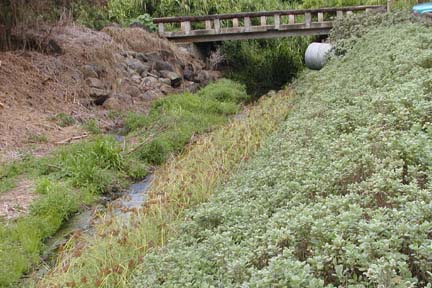
In the Garden![]()
Rick Barboza
HUI KU MAOLI OLA
Erosion
Got Erosion? ... Plant!
RAINS IN full effect it can be quite a blessing. The rain helps to replenish the diminishing aquifers that give us fresh drinking water; it signals to our native stream fish (oopu) and shrimp (opae) that it's time to send the offspring out into the ocean to begin the first steps in their life cycle; and it makes for a greener Hawaii, feeding hungry plants affected by drought.However, all this rain can cause a problem in terms of controlling erosion that can stem from it. Barren, denuded hillsides and slopes can become heavily eroded during prolonged rainfall. Generally, this eroded "muddy" material ends up streaming down slopes and onto roads, finding its way to storm drains and, eventually, into streams that lead to the ocean. From here the silt is deposited onto coral reefs, blocking out their sunlight and choking them to death.
What many homeowners do not realize is that they can be held responsible for the damage caused by the erosion that comes from their property, prompting a visit from the Hawaii State Department of Health's Clean Water Branch and resulting in a pretty hefty fine, depending on the severity of the damage.
So what should you do? Obviously, if you're experiencing this problem now with all the rain that's fallen, it's a little too late. A quick, inexpensive fix would be to cover the hillside (assuming that it is not too steep) with coarse mulch. Mulch absorbs the impact of the raindrops, soaks up water and eases it into the ground. It's comparable to a slow-drip irrigation system.
There are a few establishments that recycle green waste material and distribute coarse mulch free. This not only helps with controlling erosion, but adds nutrients to the soil and keeps the weeds out at the same time.
As long as the rainfall isn't heavy enough to flood and carry the mulch away, this method can be a temporary Band-Aid until the rain dies down and you make the fix permanently by planting the area.
A less frugal approach would be to cover the affected area with erosion-control matting made from woven coconut husks, which is held in place with wooden stakes. This has the same effect as the mulch technique but can be applied to steeper slopes since the stakes keep it in place. You can even cut the mat and plant into it.
HUI KU MAOLI OLA
The foreground slope is planted with erosion controlling pohinahina while the far slope, which has yet to be planted, shows signs of erosion. At the base of the pohinahina-planted slope is a native shrub called 'Ahu'awa (Cyperus javanicus) which has a strong fibrous root system that holds the soil in place at the edge of the stream.
AFTER THE RAINS subside, the best thing to do to control that eroding slope is to plant on it. Over the years, my company has worked on many projects aimed at controlling erosion, primarily on stream banks that are left unplanted and are eroding directly into the water. What we've come up with is a mix of plants that work well together.
The first plant that we use is pohinahina (Vitex rotundifolia). It is a quick grower that sends out long runners that root wherever a node (the point of a plant where new leaves or roots emerge) touches the ground. This is helpful because roots are what hold soil in place. These can be planted every 2 feet, and within one to three months, the planting should be quite dense.
Within the pohinahina planting, other shrubs can be added to break up the monotony. Some of these are aalii (Dodonea viscosa), which has a deep taproot and nice spread that blocks the initial impact of the rain and is quite valuable for lei making; mao (Gossypium tomentosum), also known as Hawaiian cotton, which is attractive and a far spreader; naio (Myoporum sandwicense), otherwise known as false sandalwood, a fast grower with dense, dark green foliage; kului (Nototrichium sandwicense), with nice foliage and a fibrous root system; and aweoweo (Chenopodium oahuensis), a fast grower that produces many seedlings, which increase the number of plants in the ground over time.
In general, the plants listed above are great for areas that receive only periodic heavy rains. They are all very drought-tolerant and maintain their fullness even in the driest conditions. Also, they grow quickly and require little maintenance once established; all they need is full sun.
In areas that are heavily shaded, plants such as ferns -- palapalai (Microlepia strigosa), kupukupu (Nephrolepis exalta, N. cordifolia) and hapuu (Cibotium spp.) -- work well. Although the hapuu is slow growing, it sends out a fibrous network of fern roots over time. Other shrubs and trees that also work in combination with the fern ground cover are common green-leaf ti (Cordyline fruiticosa), papala (Charpentiera spp.), papala kepau (Pisonia spp.) and alahee (Psydrax odorata), to name a few.
Although erosion is a natural process -- it helped shape the islands into what we see today -- we are living in a very unnatural environment. The presence of people on these islands has increased the rate of erosion exponentially.
From land clearing for development to the introduction of feral ungulates that eat the land clean, we are losing soil faster than nature can replenish. This has repercussions not only for the land, but the ocean and creatures within it.
Rick Barboza co-owns Hui Ku Maoli Ola, a native Hawaiian plant nursery, with Matt Schirman. Contact him at 259-6580 or e-mail rickckbarboza@aol.com. "In the Garden" is a Friday feature.
Gardening Calendar



